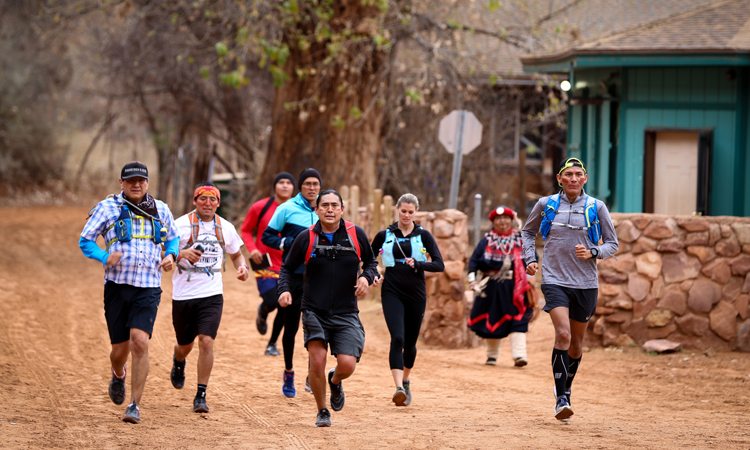The beat of a single drum rang out as Dianna White Dove Uqualla sang a prayer for a group of runners about to climb out of the deep crevasse of the Grand Canyon.
“This is a blessing song for all of you,” said Uqualla, who hails from a long line of respected healers of the Havasupai Tribe. “You’ve blessed us much with your journey.”
Thus blessed, the six Native American runners and a guest headed to finish the more than 20 miles of Grand Canyon trails, but not before they collected 25 handwritten letters from the children of Havasupai Elementary School. Each was addressed to President Donald Trump, asking him to stop new uranium mining near their homes within the canyon.
The campaign is “an adolescent plea with the president to not gamble with their future,” one tribal member said.
Tribal members fear their future will be in jeopardy if Energy Fuels Inc. gets its way. The company owns a uranium mine that sits a few miles off the South Rim entrance to Grand Canyon National Park. Energy Fuels is continuing preparations to open Canyon Mine after the U.S. 9th Circuit Court of Appeals affirmed it is not subject to a mining ban imposed by the Obama administration in 2012. The appellate court upheld parts of the ban, which was enacted so that health officials could gauge the effects of uranium mining on the Grand Canyon’s complex ecosystem.
The children’s letter campaign, conducted on Valentine’s Day, was led by a visibly emotional Arizona Rep. Eric Descheenie, D-Chinle, who waited for other runners at a footbridge that guides hundreds of thousands of people a year over the turquoise waters of Havasu Creek into Supai and the waterfalls that tumble beyond the village.
“The kids down here are being told that their futures may be in peril,” Descheenie said. “I don’t want them exposed to uranium. My children are in elementary school. Havasupai Elementary School is here. To be able to elevate their voices to the most powerful man in the free world is an honor. It’s the epitome of privilege when it comes to leadership.”
The people and the run
The Havasupai – the name means people of the blue-green waters – are one of the smallest tribes in North America, and they’ve battled canyon mining for decades.
“We are very connected to our land from thousands of years ago,” Uqualla said. “The water, the land and the ability to survive was why (our elders) picked here. And we raise our babies in this water.”
Supai is nestled within Havasu Canyon, which is adjacent to Grand Canyon National Park. The tiny village was established in 1880 and is accessible only by foot, horse, mule or helicopter. Bracketed by red rock canyons, it sits on the southern bank of the Colorado River, 56 miles from Canyon Mine atop the rim. But Havasupai officials fear mine contaminants will seep into the groundwater, harming their children and destroying the tribe’s way of life.
More than 60 percent of the Havasupai Tribe are younger than 18, according to a 2016 University of Arizona Community Profile.
“The children have a strong voice,” said Jonathan Nez, vice president of the Navajo Nation, who joined Descheenie and other supporters as a show of tribal solidarity, “and we let them know that their ancestors fought very hard to continue their way of life. They are doing the same by writing these letters.”
An eighth-grader at Havasupai Elementary said she appreciated the opportunity to be heard beyond the walls of their remote canyon.
“It’s incredible, because I didn’t know other people knew Supai existed,” Tajh-Rae Deroche said. “It’s really awesome to have them here come and help us make a bigger voice out of us.”
Some Havasupai members keep their distance from the tourists who flock to their village. They usually aren’t open to allowing reporters onto their land. Generally, they don’t allow videotaping or filming, and most villagers decline to speak to reporters.
However, on this occasion, some made an exception, hoping to get the word out on the run and its mission.
“I really hope that wherever these recordings or things are going that people will really listen, and that truth of what we need to do for the human race is in this word,” Uqualla said.
A history of discord
In 2012, the Obama administration imposed a 20-year ban on uranium mining to research its potential effects on the Grand Canyon’s ecosystem. The ban was supported by Native Americans who note that uranium mining on some reservations has had tragic consequences.
“We’ve been hurt so much by uranium exploration in tribal communities,” Nez said. “That legacy is there, and nobody is there to clean up the mess.”
According to Grand Canyon Trust, an environmental group, the Pinenut uranium mine on the North Rim of the Grand Canyon, also owned by Energy Fuels, filled with more than 3 million gallons of contaminated water after the mine ceased operations in the early 1990s. A faulty mine-shaft seal was blamed.
In 1979, an estimated 94 million gallons of contaminated water spilled from a uranium mine in Church Rock, New Mexico. The cleanup, and the effects of the spill, are still affecting those who live in that area almost four decades later.
The Obama administration instituted a 20-year ban on uranium mining near the Grand Canyon for research on its dangers. The 9th District Court reaffirmed the ban in December 2017, but lifted or struck down challenges to six mines. Preliminary work on Canyon Mine, which sits less than 10 miles south of the South Rim entrance of Grand Canyon National Park and less than 6 miles from Grand Canyon National Park Airport, began before 2012, and the company claimed “grandfather” status to continue work.
The science
According to the Centers for Disease Control and Prevention, uranium mining has been linked to many forms of cancer and kidney diseases.
Effects on water supplies also have been an issue. Roger Clark, program director at the Grand Canyon Trust, has written multiple blogs outlining the potential dangers Canyon Mine presents.
“There’s an underground mining operation occurring 5,000 feet above a major aquifer, a regional aquifer,” Clark said, referring to the Canyon Mine. “If all water is removed from the shaft, then most risk of groundwater contamination can be eliminated. Last summer, before Canyon Mine even struck ore, it hit a perched aquifer. And then they ran out of room in the containment pond and couldn’t pump any more water out of the shaft.”
Clark said Canyon Mine released the excess contaminated water into the atmosphere by way of misters, and used trucks to speed up the removal process.
The aquifer, named the Redwall-Mauv, feeds many water seeps and springs inside the Grand Canyon and is Havasupai’s sole source of drinking water. Water from this aquifer flows into Havasu Canyon, which feeds directly into Havasu Creek, according to the Grand Canyon Trust.
Uranium oxide is water-soluble and deadly. It may not show up for years, Clark said, but the threat remains.
To prevent this from happening, mining companies and individual mines must pass tests required by the Environmental Protection Agency, the federal Bureau of Land Management, U.S. Forest Service, and the Arizona Department of Environmental Quality before mining can begin.
Every day, uranium erodes naturally into the Grand Canyon. Currently, there’s no approved tribal water quality standards and no proposed or promulgated standards are applicable to the Havasupai Tribe, according to the EPA.
The mine
Energy Fuels Inc. formed in Toronto, and its head office remains in Canada. Its U.S. corporate headquarters are in Colorado. Company officials deny the Canyon Mine operation will harm the Havasupai or the environment.
Energy Fuels guarantees at “99.999 percent certainty” that the groundwater will not be impacted by Canyon Mine, due to the amount of regulation placed on the company before, during and after the completion of mining activity. Curtis Moore, vice president of marketing and corporate development for Energy Fuels, said Canyon Mine is in compliance with all state and federal government regulations.
Clark is skeptical.
“Uranium mining, is as far as we can tell, the only form of mining in the state that doesn’t require groundwater monitoring,” he said. “If (Energy Fuels) is that sure, then they should have no problem paying for and installing at least three groundwater monitoring wells around Canyon Mine.”
The underground uranium deposit was discovered at Kaibab National Forest in the late 1970s. The mine that sits above it is classified as a small uranium and copper mine stretching 12 to 15 acres.
Moore said the mine has the potential to yield 2 million pounds of uranium, which could fuel Arizona for a year. In addition to its use in power production, uranium has military uses, including the production of weapons.
“We get about 20 percent of our electricity in the United States from nuclear; and about 60 percent of our carbon free energy from nuclear,” Moore said.
On a personal level, he said, he cares for the Grand Canyon’s landscape and the Havasupai people.
“I wish we could show them there’s really going to be no impact from this mine on their town of Supai, on Havasu Creek, on any of the creeks, or seeps, or springs, or anything inside the Grand Canyon,” Moore said. “If I really thought that there was any chance that we were going to harm any of it, I simply couldn’t work for this company.”
Energy Fuels executives have said they disagree with previous news media coverage of the company, after press reports highlighted its role as a major lobbyist in bringing back uranium mining, supported by policies put in place by the Trump administration.
Chief executive officer Mark Chalmers sent a letter to employees, responding to a recent article in “The New York Times.”
In it, Chalmers said the piece was “full of innuendo, half-truths, obfuscation, and conspiracies, including a major distortion of our position on Bears Ears National Monument.”
Owners of U.S. nuclear power reactors purchased 50.6 million pounds of uranium in 2016. Only 11 percent of the uranium delivered to U.S. reactors was produced in the U.S. in 2016, according to the U.S. Energy Information Administration.
Impact on tribe and traditions
Generation after generation, the Havasupai teach their young that water needs to be treated with respect because one day, it will be worth more than gold.
“They taught us these things growing up, and this is why I’m so strong in my traditional walk (acknowledgment of tribal traditions),” Uqualla said. “In this time, we’re looking very much at making sure our home is here, and our children have a place to call home. People have to have a home, otherwise they feel lost.”
Hikers also worry about what will happen to the natural beauty of the canyon if mining resumes.
“It’s magnificent. I can’t imagine that they would actually go through with mining,” Brian Rickerson said a hiking out of Havasu Canyon. “I don’t think uranium mining should happen at all down here. I’m from Florida, and I’ve seen what happens when the government and-or industry gets involved with the ecosystem.”
And the Havasupai worry about what will happen to them economically if people stop coming to the canyon.
The tribe sold off it casino rights and have cut ties with banking conglomerates that damage the environment. Now they rely on revenue from a 24-room lodge, a trading post, a cafe and its guided tours and campgrounds. Tourism is the primary source of revenue.
According to Grand Canyon Adventures, a 2018 single-day camping rate is $140.56 per person. That means the Havasupai can host an estimated 127,750 tourists this year. The tribe issues 350 camping permits daily, with permits selling out within months of going on sale. That’s nearly $18 million per year in tourism revenue on the low end.
The median household income is $25,833, with the more than 90 percent of the those employed working for the federal government.
What’s next
After the seven runners made it out of the canyon, letters in hand, Descheenie flew to Washington, D.C., where he was met by Havasupai Tribal Councilwoman Carletta Tilousi and Jackson Brossy, executive director of the Navajo Nation Washington Office. The three delivered the letters to William H. Kirkland, special assistant to the president and deputy director of intergovernmental affairs, on Feb. 16.
“We need to continue to look long term about how we can take care of our most vulnerable populations,” Descheenie said. “At the end of the day, it’s industry, it’s business, it’s commerce. This country’s history is rooted in just that. When it’s a matter of life and death, it’s a no-brainer. The answers should be ‘No.’ ”
Meanwhile, officials with Energy Fuels Inc. said extraction hasn’t started yet at Canyon Mine, and preparations are still underway.
For the Havasupai Tribe, the battle is not over yet.
“This land is a part of us,” Uqualla said. “We’re trying to ensure that our children have this land for years to come. We are the rocks. We are the people. We are a part of this world. One mind, and one heart.”
Story by CHRISTOPHER CADEAU and LILLIAN DONAHUE, Cronkite News




